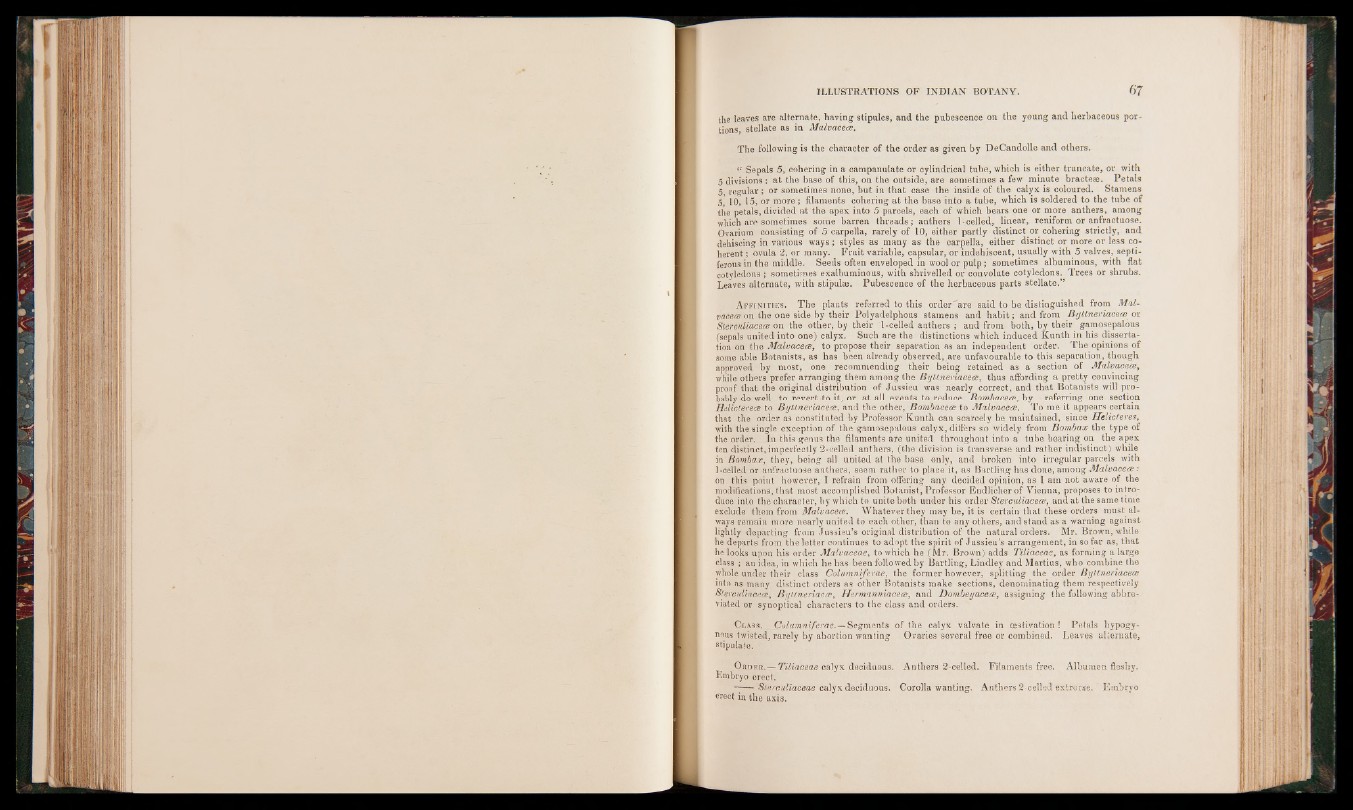
the leaves are alternate, having stipules, and the pubescence on the young and herbaceous portions,
stellate as in Malvacece.
The following is the character of the order as given by DeCandolle and others.
“ Sepals 5, cohering in a campanulate or cylindrical tube, which is either truncate, or with
5 divisions : at the base of this, on the outside, are sometimes a few minute bracteae. Petals
5 regular; or sometimes none, but in that case the inside of the calyx is coloured. Stamens
5* 10, 15, or more; filaments cohering at the base into a tube, which is soldered to the tube of
the petals, divided at the apex into 5 parcels, each of which bears one or more anthers, among
which are sometimes some barren threads; anthers 1-celled, linear, reniform or anfractuose.
Ovarium consisting of 5 carpella, rarely of 10, either partly distinct or cohering strictly, and
dehiscing in various ways; styles as many as the carpella, either distinct or more or less coherent
; ovula 2, or many. Fruit variable, capsular, or indehiscent, usually with 5 valves, septi-
ferous in the middle. Seeds often enveloped in wool or pulp; sometimes albuminous, with flat
cotyledons; sometimes exalbuminous, with shrivelled or convolute cotyledons. Trees or shrubs.
Leaves alternate, with stipulae. Pubescence of the herbaceous parts stellate.”
A ffinities. The plants referred to this order “"are said to be distinguished from Malvacece
on the one side by their Polyadelphous stamens and habit; and from Bytlneriacece or
Slerculiacece on the other, by their l-celled anthers ; and from both, by their gamosepalous
(sepals united into one) calyx. Such are the distinctions which induced Kunth in his dissertation
on the Malvacece, to propose their separation as an independent order. The opinions of
some able Botanists, as has been already observed,,are unfavourable to this separation, though
approved by most, one recommending their being retained as a section of Malvacece,
while others prefer arranging them among the Byttneriacece, thus affording a pretty convincing
proof that the original distribution of Jussieu was nearly correct, and that Botanists will probably
do well to revert to it, or at all events to reduce Bombacece, by referring one section
Halicterece to Bytlneriacece, and the other, Bombacece to Malvacece. To me it appears certain
that the order as constituted by Professor Kunth can scarcely be maintained, since Helicteres,
with the single exception of the gamosepalous calyx, differs so widely from Bombax the type of
the order. In this genus the filaments are united throughout into a tube bearing on the apex
ten distinct, imperfectly 2-celled anthers, (the division is transverse and rather indistinct) while
in Bombax, they, being all united at the base only, and broken into irregular parcels with
1-celled or anfractuose anthers, seem rather to place it, as Bartling has done, among Malvacece:
on this point however, I refrain from offering any decided opinion, as I am not aware of the
modifications, that most accomplished Botanist, Professor Endlicher of Vienna, proposes to introduce
into the character, by which to unite both under his order Sterculiacece, and at the same time
exclude them from Malvacece. Whatever they may be, it is certain that these orders must always
remain more nearly united to each other, than to any others, and stand as a warning against
lightly departing from Jussieu’s original distribution of the natural orders. Mr. Brown, while
he departs from the letter continues to adopt the spirit of Jussieu’s arrangement, in so far as, that
he looks upon his order Malvaceae, to which he (Mr. Brown) adds Tiliaceae, as forming a large
class ; an idea, in which he has been followed by Bartling, Lindley and Martius, who combine the
whole under their class Columniferae, the former however, splitting the order Bytlneriacece
into as many distinct orders as other Botanists make sections, denominating them respectively
Sterculiacece, Byttneriacce, Hermanniacece, and Dombeyacece, assigning the following abbreviated
or synoptical characters to the class and orders. s
C lass. Columni ferae.—Segments of the calyx valvate in cestivation ! Petals hypogy-
nous twisted, rarely by abortion wanting Ovaries several free or combined. Leaves alternate,
stipulate.
O rder. — Tiliaceae calyx deciduous. Anthers 2-celled. Filaments free. Albumen fleshy.
Embryo erect.
—— Sterculiaceae calyx deciduous. Corolla wanting. Anthers 2-celled extrorse. Embryo
£Vect in the axis.